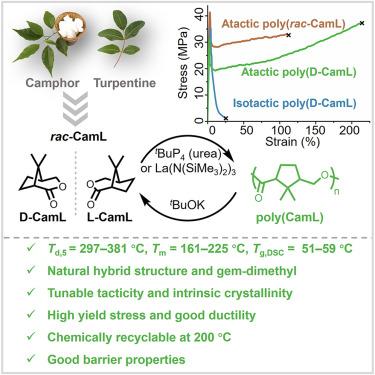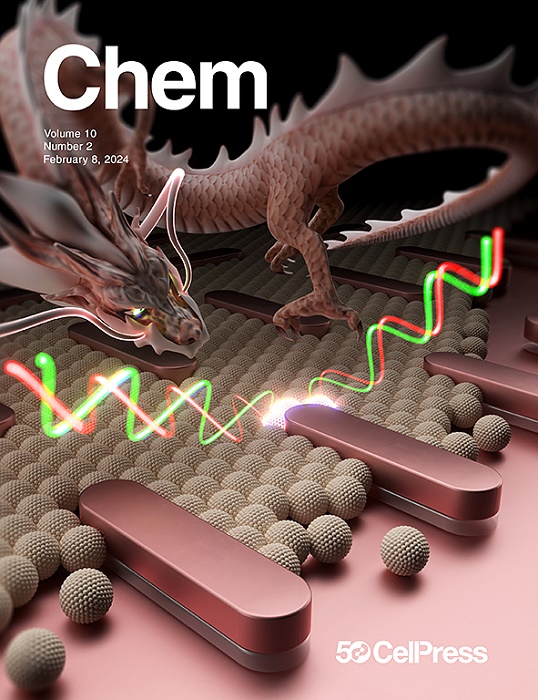Terpenoid-based high-performance polyester with tacticity-independent crystallinity and chemical circularity
IF 19.1
1区 化学
Q1 CHEMISTRY, MULTIDISCIPLINARY
引用次数: 0
Abstract
The development of chemically circular, bio-based polymers is an urgently needed solution to combat the plastic waste crisis. However, the most prominent, commercially implemented bio-based aliphatic polyester, poly(lactic acid) (PLA), is brittle, therefore largely limiting its broad applications. Herein, we introduce a class of aliphatic polyesters produced through the ring-opening polymerization (ROP) of (1R,5S)-8,8-dimethyl-3-oxabicyclo[3.2.1]octan-2-one (D-CamL) and the racemic mixture (rac-CamL), which exhibit superior material properties relative to PLA. A metal-based or organic catalyst was used for the modulation of polymer tacticity. Notably, regardless of tacticity, poly(CamL) exhibits intrinsic crystallinity, resulting in polyesters with high yield stress (24–39 MPa), high Young’s modulus (1.36–2.00 GPa), tunable fracture strains (6%–218%), and high melting temperatures (161°C–225°C). Importantly, poly(CamL) can be chemically recycled to monomer in high yield, and virgin-quality poly(CamL) is obtained after repolymerization. Overall, poly(CamL) represents a new class of bio-derived and chemically circular high-performance polyesters.


萜类高性能聚酯,具有与触觉无关的结晶性和化学循环性
开发化学循环型生物基聚合物是应对塑料废弃物危机急需的解决方案。然而,最著名的商业化生物基脂肪族聚酯--聚乳酸(PLA)却很脆,因此在很大程度上限制了它的广泛应用。在本文中,我们介绍了通过 (1R,5S)-8,8-二甲基-3-氧杂双环[3.2.1]辛烷-2-酮(D-CamL)和外消旋混合物(rac-CamL)的开环聚合(ROP)生产的一类脂肪族聚酯,与聚乳酸相比,这种聚酯表现出更优越的材料特性。金属催化剂或有机催化剂可用于调节聚合物的触变性。值得注意的是,无论触变性如何,聚(CamL)都表现出固有的结晶性,因此聚酯具有高屈服应力(24-39 兆帕)、高杨氏模量(1.36-2.00 GPa)、可调断裂应变(6%-218%)和高熔化温度(161°C-225°C)。重要的是,聚(CamL)可以通过化学方法高产率地回收为单体,并在重新聚合后获得原生质量的聚(CamL)。总之,聚(CamL)是一类新型的生物衍生和化学循环高性能聚酯。
本文章由计算机程序翻译,如有差异,请以英文原文为准。
求助全文
约1分钟内获得全文
求助全文
来源期刊

Chem
Environmental Science-Environmental Chemistry
CiteScore
32.40
自引率
1.30%
发文量
281
期刊介绍:
Chem, affiliated with Cell as its sister journal, serves as a platform for groundbreaking research and illustrates how fundamental inquiries in chemistry and its related fields can contribute to addressing future global challenges. It was established in 2016, and is currently edited by Robert Eagling.
 求助内容:
求助内容: 应助结果提醒方式:
应助结果提醒方式:


